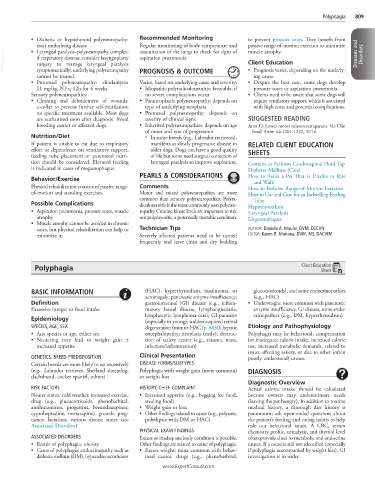Page 1607 - Cote clinical veterinary advisor dogs and cats 4th
P. 1607
Polyphagia 809
• Diabetic or hypothyroid polyneuropathy: Recommended Monitoring to prevent pressure sores. They benefit from
treat underlying disease Regular monitoring of body temperature and passive range-of-motion exercises to minimize
VetBooks.ir if respiratory distress, consider laryngoplasty aspiration pneumonia Client Education Diseases and Disorders
muscle atrophy.
auscultation of the lungs to check for signs of
• Laryngeal paralysis–polyneuropathy complex:
surgery to manage laryngeal paralysis
symptomatically; underlying polyneuropathy
ing cause.
cannot be treated. PROGNOSIS & OUTCOME • Prognosis varies, depending on the underly-
• Protozoal polyneuropathy: clindamycin Varies, based on underlying cause and severity: • Despite the best care, some dogs develop
11 mg/kg PO q 12h for 6 weeks • Idiopathic polyradiculoneuritis: favorable, if pressure sores or aspiration pneumonia.
Sensory polyneuropathies: no severe complications occur • Clients need to be aware that some dogs will
• Cleaning and debridement of wounds: • Paraneoplastic polyneuropathy: depends on require ventilatory support, which is associated
e-collar to prevent further self-mutilation; type of underlying neoplasia with high costs and potential complications.
no specific treatment available. Most dogs • Protozoal polyneuropathy: depends on
are euthanized soon after diagnosis. Avoid severity of clinical signs SUGGESTED READING
breeding carrier or affected dogs. • Inherited polyneuropathies: depends on age Anor D: Lower motor neuron tetraparesis. Vet Clin
of onset and rate of progression Small Anim 44:1201-1222, 2014.
Nutrition/Diet ○ In some breeds (e.g., Labrador retrievers),
If patient is unable to eat due to respiratory manifests as slowly progressive disease in RELATED CLIENT EDUCATION
effort or dependence on ventilatory support, older dogs. Dogs can have a good quality SHEETS
feeding tube placement or parenteral nutri- of life but some need surgical correction of
tion should be considered. Elevated feeding laryngeal paralysis to improve respiration. Consent to Perform Cerebrospinal Fluid Tap
is indicated in cases of megaesophagus. Diabetes Mellitus (Cats)
PEARLS & CONSIDERATIONS How to Assist a Pet That Is Unable to Rise
Behavior/Exercise and Walk
Physical rehabilitation consists of passive range- Comments How to Perform Range-of-Motion Exercises
of-motion and standing exercises. Motor and mixed polyneuropathies are more How to Use and Care for an Indwelling Feeding
common than sensory polyneuropathies. Polyra- Tube
Possible Complications diculoneuritis is the most commonly seen polyneu- Hypothyroidism
• Aspiration pneumonia, pressure sores, muscle ropathy. Creatine kinase levels are important to rule Laryngeal Paralysis
atrophy out polymyositis, a potentially treatable condition. Megaesophagus
• Muscle atrophy cannot be avoided in chronic
cases, but physical rehabilitation can help to Technician Tips AUTHOR: Daniela A. Mauler, DVM, DECVN
minimize it. Severely affected patients need to be turned EDITOR: Karen R. Muñana, DVM, MS, DACVIM
frequently and have clean and dry bedding
Polyphagia Client Education
Sheet
BASIC INFORMATION (HAC), hyperthyroidism, insulinoma, or glucocorticoids), and some endocrinopathies
acromegaly; pancreatic enzyme insufficiency; (e.g., HAC)
Definition gastrointestinal (GI) disease (e.g., inflam- • Underweight: more common with pancreatic
Excessive hunger or food intake matory bowel disease, lymphangiectasia, enzyme insufficiency, GI disease, some endo-
lymphocytic lymphoma-cats); GI parasites crinopathies (e.g., DM, hyperthyroidism)
Epidemiology (especially in young); sudden acquired retinal
SPECIES, AGE, SEX degeneration (mimics HAC [p. 883]); hepatic Etiology and Pathophysiology
• Any species or age, either sex encephalopathy; neoplasia (early); destruc- Polyphagia may be behavioral, compensation
• Neutering may lead to weight gain ± tion of satiety center (e.g., trauma, mass, for inadequate caloric intake, increased caloric
increased appetite infection/inflammation) use, increased metabolic demands, related to
issues affecting satiety, or due to other (often
GENETICS, BREED PREDISPOSITION Clinical Presentation poorly understood) causes.
Certain breeds are more likely to eat excessively DISEASE FORMS/SUBTYPES
(e.g., Labrador retriever, Shetland sheepdog, Polyphagia with weight gain (more common) DIAGNOSIS
dachshund, cocker spaniel, others) or weight loss
Diagnostic Overview
RISK FACTORS HISTORY, CHIEF COMPLAINT Actual caloric intake should be calculated
Neuter status, cold weather, increased exercise, • Increased appetite (e.g., begging for food, because owners may underestimate needs
drug (e.g., glucocorticoids, phenobarbital, stealing food) (leaving the pet hungry). In addition to routine
antihistamines, progestins, benzodiazepines, • Weight gain or loss medical history, a thorough diet history is
cyproheptadine, mirtazapine), growth, preg- • Other findings related to cause (e.g., polyuria, paramount; ask open-ended questions about
nancy, lactation, various disease states (see polydipsia with DM or HAC) the patient’s feeding and eating habits to help
Associated Disorders) rule out behavioral issues. A CBC, serum
PHYSICAL EXAM FINDINGS chemistry profile, urinalysis, and thyroid level
ASSOCIATED DISORDERS Excess or inadequate body condition is possible. often provide clues to metabolic and endocrine
• Result of polyphagia: obesity Other findings are related to cause of polyphagia. causes. If a cause is still not identified (especially
• Cause of polyphagia: endocrinopathy such as • Excess weight: more common with behav- if polyphagia accompanied by weight loss), GI
diabetes mellitus (DM), hyperadrenocorticism ioral causes, drugs (e.g., phenobarbital, investigation is in order.
www.ExpertConsult.com

